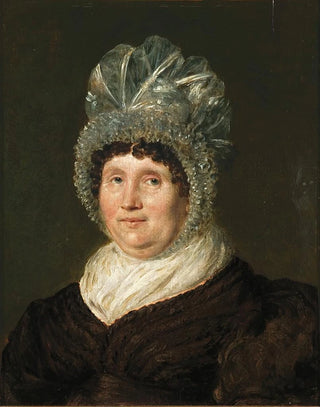Art print | Mme Clare - John Linnell


View from behind

Frame (optional)
In the rich and complex universe of 19th-century British art, the art print "Mme Clare" by John Linnell stands out for its delicacy and psychological depth. This painting, which captures the very essence of its subject, embodies an era when portraiture was not only a reflection of reality but also an exploration of human emotions. The depiction of Mme Clare, with her contemplative gaze and subtle expression, invites the viewer to delve into the intimacy of her inner world. It is a work that transcends the simple act of painting to become a true testament to the Victorian era, where art intertwined with daily life with unmatched elegance.
Style and uniqueness of the work
Linnell's style in "Mme Clare" is characterized by meticulous attention to detail and mastery of light and shadow nuances. The artist manages to create an intimate atmosphere, where each brushstroke seems to breathe life. The colors, carefully chosen, evoke a soft and harmonious palette, enhancing the palpable emotion emanating from the portrait. Mme Clare's posture, both natural and poised, reflects a sensitivity that echoes the romantic vision of art of the time. The background, understated and discreet, highlights the subject while adding depth that emphasizes the contemplative nature of the work. This marriage of technique and emotion makes "Mme Clare" a unique piece, capable of capturing the eye and mind of anyone who gazes upon it.
The artist and his influence
John Linnell, often overshadowed by more famous contemporaries, nonetheless had a significant impact on the artistic landscape of his time. Raised in an environment where art and culture were omnipresent, he developed a style that blends realism with a poetic dimension. His work, influenced by the Pre-Raphaelites and old masters, reflects an unceasing quest for beauty and truth. Linnell also played a crucial role in promoting other artists, acting as a mentor and supporter for figures such as Samuel Palmer. His artistic vision, centered on humanity and nature, continues to inspire

Matte finish

View from behind

Frame (optional)
In the rich and complex universe of 19th-century British art, the art print "Mme Clare" by John Linnell stands out for its delicacy and psychological depth. This painting, which captures the very essence of its subject, embodies an era when portraiture was not only a reflection of reality but also an exploration of human emotions. The depiction of Mme Clare, with her contemplative gaze and subtle expression, invites the viewer to delve into the intimacy of her inner world. It is a work that transcends the simple act of painting to become a true testament to the Victorian era, where art intertwined with daily life with unmatched elegance.
Style and uniqueness of the work
Linnell's style in "Mme Clare" is characterized by meticulous attention to detail and mastery of light and shadow nuances. The artist manages to create an intimate atmosphere, where each brushstroke seems to breathe life. The colors, carefully chosen, evoke a soft and harmonious palette, enhancing the palpable emotion emanating from the portrait. Mme Clare's posture, both natural and poised, reflects a sensitivity that echoes the romantic vision of art of the time. The background, understated and discreet, highlights the subject while adding depth that emphasizes the contemplative nature of the work. This marriage of technique and emotion makes "Mme Clare" a unique piece, capable of capturing the eye and mind of anyone who gazes upon it.
The artist and his influence
John Linnell, often overshadowed by more famous contemporaries, nonetheless had a significant impact on the artistic landscape of his time. Raised in an environment where art and culture were omnipresent, he developed a style that blends realism with a poetic dimension. His work, influenced by the Pre-Raphaelites and old masters, reflects an unceasing quest for beauty and truth. Linnell also played a crucial role in promoting other artists, acting as a mentor and supporter for figures such as Samuel Palmer. His artistic vision, centered on humanity and nature, continues to inspire






